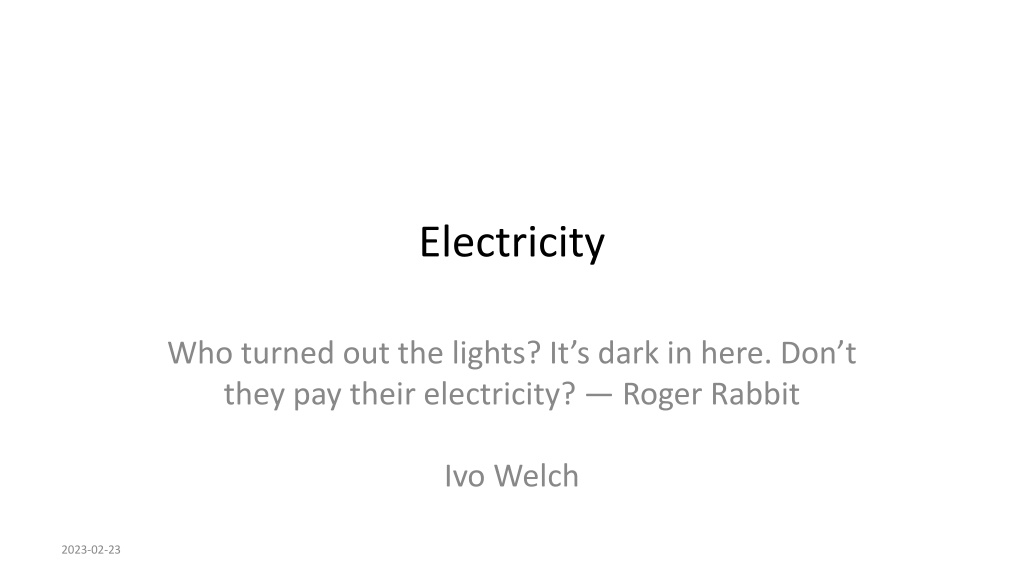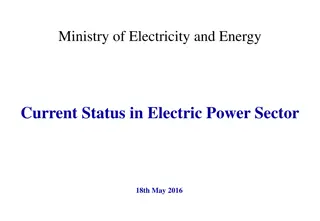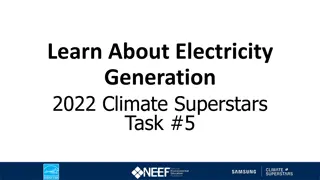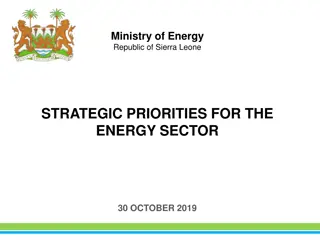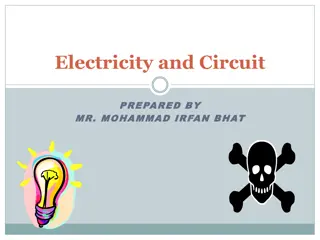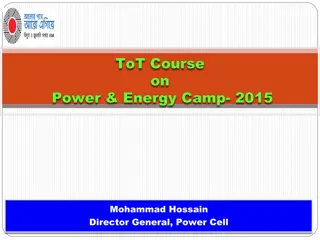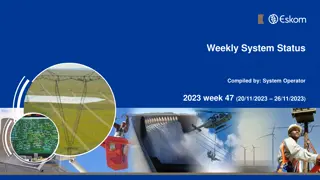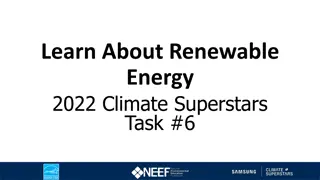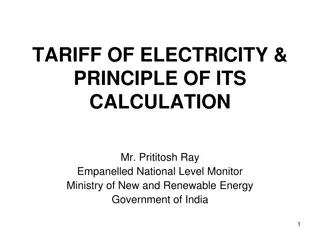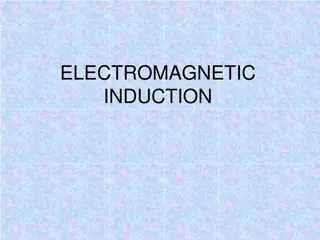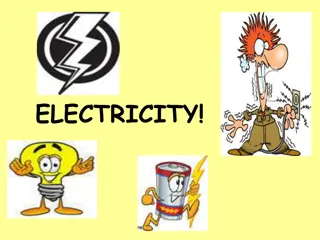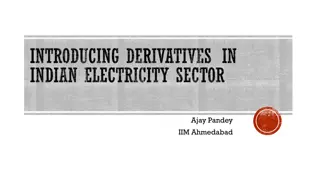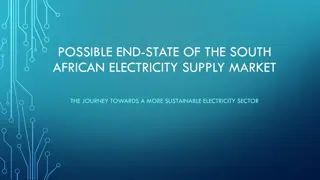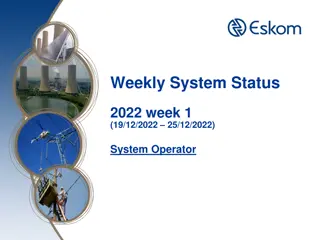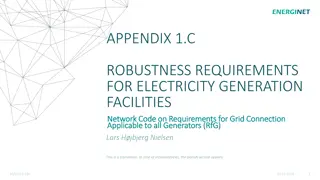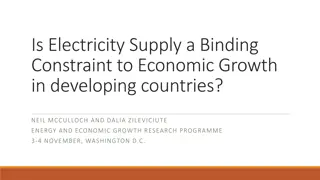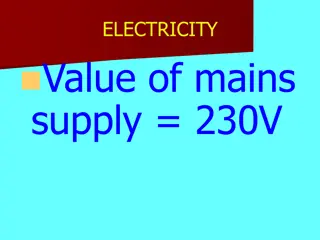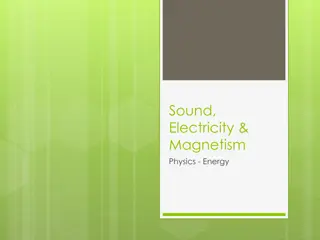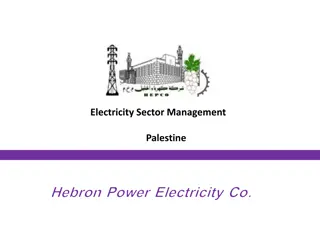Understanding Electricity Generation and Future Trends
Exploring the complexities of electricity generation, this content delves into the importance of clean energy sources like wind and solar power. It discusses the challenges of heterogeneous electron distribution, the mix of energy sources in the USA, and the considerations in building new utility-scale plants. The future direction points towards increasing competitiveness of renewables and a shift away from traditional fossil fuels.
Download Presentation

Please find below an Image/Link to download the presentation.
The content on the website is provided AS IS for your information and personal use only. It may not be sold, licensed, or shared on other websites without obtaining consent from the author. Download presentation by click this link. If you encounter any issues during the download, it is possible that the publisher has removed the file from their server.
E N D
Presentation Transcript
Electricity Who turned out the lights? It s dark in here. Don t they pay their electricity? Roger Rabbit Ivo Welch 2023-02-23
Warning Quoted numbers in these slides are ca 2021. Current Ukraine war effects. Not completely clear what future will hold except that renewables will become more and more competitive!
Why Electricity? Clean! High-quality Jack of all Trades: Fossil fuels are one-trick ponies, perfect economics only for heat. Already know e-tech will improve greatly. No moonshots necessary but welcome. PS: Read up on primary vs. nameplate power.
Heterogeneous Electrons are electrons, but Time and location matter Noon vs 8pm Nevada vs. New York Allocation problems are tremendous: uncertainty (supply and demand); short-term (which plants to switch on); long-term (which plants to build where); how to move e around (transmission).
World Even more heterogeneous than USA. Discuss US / California first: Illustrative only, and good to explain basic workings. It is not enough to decarbonize US!
USA Generation U.S. NatGas Coal Wind Power 45% 20% 10% Energy 40% 20% 9%
U.S. Nuclear Hydro Solar Power 10% 10% 5% Energy 20% 7% 2%
Utility-Scale High Fixed Costs Plants are built primarily when demand grows, and/or old plants age out. US demand is mostly stable: US builds new plants mostly when (old coal and nuclear plants) age out.
New Plants: USA For many years now, only Wind and Solar; will probably continue; explain below why. A few new NatGas plants on East Coast. 32GW (out of 500GW) in dvlpmnt pipeline, though. existing NatGas plants are beginning to install solar panels to save variable cost. Very rare nuclear plant here and there (Terapower). No new coal plants, few new dams, etc. PS: Oil is always uneconomic, except in emergency generators (and New Hampshire?). Used in 3rd world.
New Plants: World, Other China, India, etc.: Large new building programs. Lots of new Wind and Solar plants. Some nuclear plants, some others. But huge coal plant building programs: 270 GW in China And new world record in 2021; And coal employs millions of people!
Transmission Grid Transmission grid is expensive. Think $1-$50/MWh. Distance matters! Supply is cheaper close to demand. Low current transmission cost only because of generation proximity.
USA Transmission Mess Complex regulation, tying in, etc.: Regulators captured by > 3,000 utility companies, with some good reason, and a lot of lobbyists and lawyers, and big hurdles for competitive clean engineering innovators inexperienced in politics. and NIMBY
Electricity Allocation Problems Complex problems abound. Only known good allocation system: Competitive but Managed Electricity Markets!
Electricity Allocation Problems But free market must be shepherded! alternative free-for-all cannot work either; needs regulation, but is still somewhat manipulatable and indeed manipulated. Compromises between scylla and charybdis.
California Details are fascinating stuff. They are important, but vary by place In California (not elsewhere): Capacity auctions for new plants (3 years); Power auctions for delivery (daily).
Today https://www.caiso.com/todaysoutlook/Pages/index.html
Today https://www.caiso.com/todaysoutlook/Pages/supply.html
Today (2023, Much Higher!) https://www.caiso.com/todaysoutlook/Pages/prices.html
Inexact Classification 1. Baseload Power. Think Nuclear. 2. Intermittent Power. Think Wind and Solar. 3. Storage (Dispatchable Power). Think Batteries and Hydroelectric Dams.
Power Mix Comparison Nuke GeoT Coal Gas Calif 9% 5% 3% 34% USA 20% 1% 19% 40% World 10% 0% 37% 24%
Hydro Wind Solar Other Calif 18% 10% 12% 9% USA 7% 9% 2% 2% World 16% 5% 3% 5%
Generation Costs: Building Plants 1. Electricity s biggest cost is typically upfront plant building cost: Construction / capital. Plant scalability varies: biggest scale needed for nuclear, most flexible scale for Wind and Solar. Cost of grid tie-in is high, too, incl. regulatory costs, and does not scale linearly.
Generation Costs: Running 2. Idle (Standby) Minimum Running Cost: capital interest costs; personnel and maintenance; obsolescence. 3. Active Generation Cost: Fuel and Extra Wear: Highest for Fossil fuels; Medium for Nuclear; Lowest for Wind and Solar.
Levelized Cost Of Electricity (LCOE) Tries to take all costs into account. Projected over lifetime of plant: disagreement over lifetime different LCOEs. If you got it wrong, you may lose a lot of money. Following are ballpark inflation-adjusted figures, differ by location, regulation, etc.
Ballpark LCOEs Per MWh Type Today est 2050 Solar Panels, Roof $100 $30 Solar Panels, Utility $35 $15 Wind, onshore $35 $20 Geothermal $35 Nuclear $70 $60 Gas, Always On $40 $45 Coal $75 $65 Hydro $55 Gas, Dispatch $200
Really? Wowee! Wind and Solar are the cheapest large-scale sources of energy that civilization has ever seen! and they will become even cheaper! Unbelievably cheap, too cheap to meter! computers but they do not always work.
Solved Problem! Clean intermittent generation for cheap is a basically a solved science problem: $15/MWh or $5/MWh is relatively unimportant. The silicon solar cell component will soon be negligible part of solar plant cost. Costs will be primarily connections / running / maintenance. Often best to colocate Solar, Wind, Batteries to share connection and operation costs.
Natural Gas NatGas is cheapest on-demand source of power in the USA: Turn off, turn on. Nearly infinite capacity, but not as abundant everywhere else. $40-$200/MWh cheap, tough to beat. on demand: $80- Maybe should add $20/MWh for pollution. NatGas often leaks on pipes and at EOL. Makes NatGas look cleaner than it is.
Geothermal And Hydro (Storage) Think $100-$250/MWh Requires large scale: Environmental opposition to hydro. PS: small-scale geothermal works well for home heating cooling and is economical! Cheap running cost. No fuel required. Very limited supply of good locations PS: Also consider compressed air in caverns.
Nuclear Power (Again) Primary nuclear problem today: Fixed cost ($20 billion/plant). 10 years: potentially obsolete before open. Honest Disagreements: Put your money where your mouth is? Gates, France, China are bullish. UnionCScientists, Germany are bearish.
Coal: USA Hated and obsolete. But kept alive by: Abundant availability and e-needs now. Fossil fuel subsidies and lobbies. Large employment bases, pivotal voters. Still, fortunately, plants are aging out now, Unfortunately, just like clean nuclear plants. USA, 250 plants + 0 uc (construction)
Coal: Think Global Coal is still hated and obsolete. But growing countries need power now. Coal consumption and coal plants set new records in 2021! Long-term, coal faces likely stagnation, not immediate obsolescence.
Coal: Think Global The World s Real Problem: China, 1000 + 200uc . India, 250 + 50uc . World, 2,000 + 500uc . Once built, sunk-cost equation changes: 30-50-year lasting impact!! Any good ideas? Now is the time!
Dispatchable (Storage) If demand is reasonably constant, choose either basepower; or intermittent + storage; basepower + storage is not so great.
Simplified Power connection infrastructure is expensive, more so for intermittent power. Optimal solutions are often messy mixes. One size ``no fit all.
Clean Energy In sum: Problem is No Longer Cheap Generation! Problem Now is Cheap Energy Storage! Solve it, and wind/solar will take over.
Lithium Batteries Think $200/MWh. Li comes in small manufactured cells. Cells are finicky and small. Not easily scalable: Expensive packaging into small cells. Twice the capacity is approx twice the cost. Lots of mundane improvements, but will likely always be finicky small-scale.
Current Big Lithium Problem Problem: Wear out after 1,000 cycles. Anode and cathode expand and contract. But very soon 3,000 - 5,000 cycles! Much cheaper for long-run use. Very big deal for utility-scale storage. Could bring price down to $100/MWh? Use your EV car for storage? PS: No scientific reason why not 50,000 cycles, either.
Utility-Scale Lithium In USA 2 GW power out of 450 GW total. 10 GWh energy out of 4,000,000 GWh. Problem is capacity, not power. Batteries rapidly expanding, but still tiny: Many specialty uses (e.g. 6-10pm). Still too expensive for overnight, much less for multi-day storage.
Flow And Other Batteries World Need: Giant house-sized tubs with person-sized electrodes that scale according to whim, with quad storage only double cost, with cheap chemistries, $50/MWh, and then it will be lights-out for most power plants other than wind and solar in 20-30 years! at $150/MWh, we could make it to 95%! Rust Batteries?
Utility-Scale Flow Batteries Possible, even likely. But not here yet. Better to spend lots of $$$s now on research and development than on deployment now. I am optimistic. (10 years?) But what if I am overoptimistic? This is not a solved problem!
Hydro-Electric Power Think $250/MWh. Categories: Flow, Dammed, Pumped. Limited Potential (but still 2x today s). High capacity, lower efficiency than batteries: Still cheaper for big energy needs. Here now and can supply 8-12 hours! Some even multi-day (Hoover).
Hydro-Power Problem Few suitable locations. Large scale only. Extremely high upfront fixed cost. What if battery power becomes cheaper more quickly than expected?
Unconventional Solutions Trains schlepping weights up a hill?! Maybe not crazy at all?: Maybe $100-$200/MWh ? Perhaps not great long-run solutions, but temporarily not uncompetitive either (for now)?
